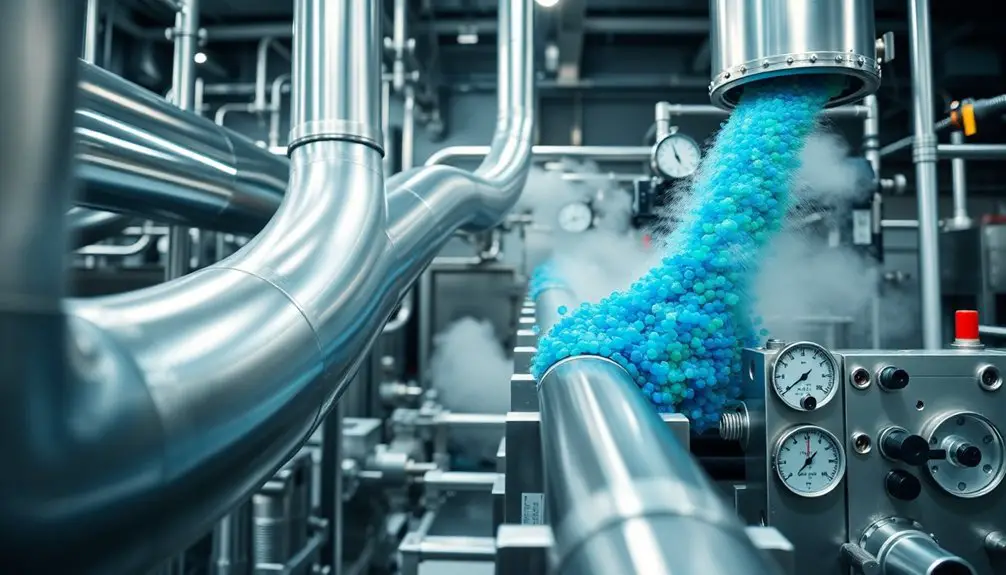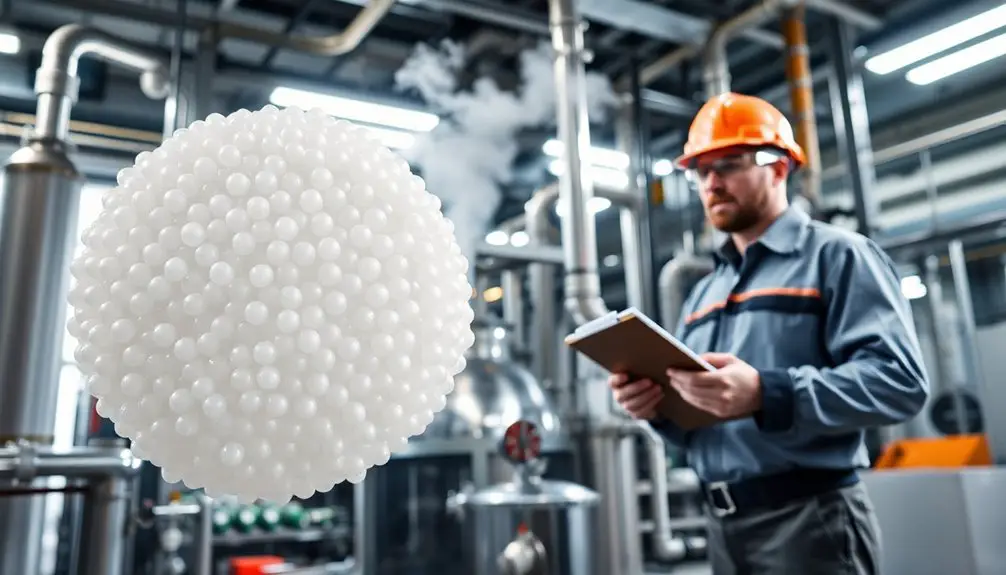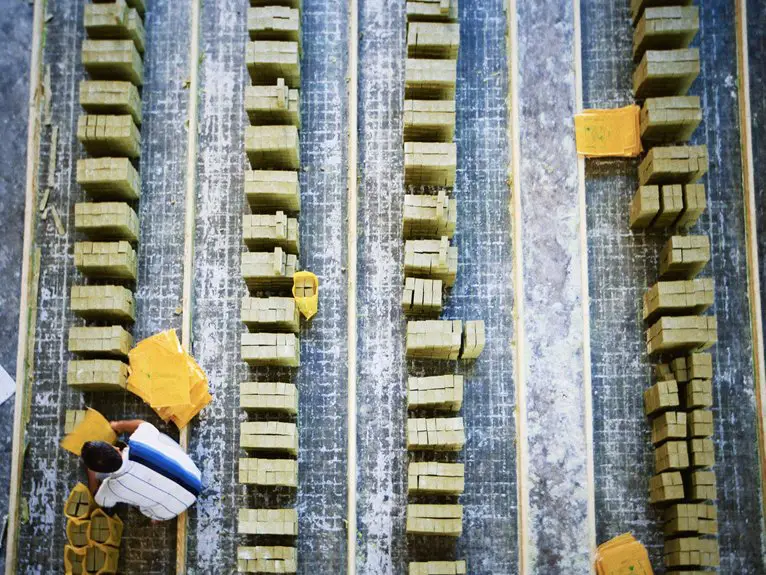To make polypropylene, you start with propylene gas, which you obtain through naphtha cracking. Next, you'll purify it to remove impurities before adding catalysts like Ziegler-Natta or metallocene to control molecular structure. You can then choose a polymerization method, either gas-phase or liquid-phase, depending on the properties you need. Once the polymer is formed, customize it by incorporating additives for strength, flexibility, or color. Finally, implement quality assurance tests to ensure the product meets industry standards. There's a lot more to explore about the nuances of the process, so keep going to discover additional insights.
Key Takeaways
- Propylene gas is the primary raw material for polypropylene, derived from naphtha cracking and purified to remove impurities.
- Polymerization processes, including gas-phase and liquid-phase, utilize catalysts to control the molecular structure of polypropylene.
- Customization involves adding additives, comonomers, and colorants to tailor polypropylene for specific applications and enhance performance.
- Quality assurance techniques like melt flow index tests and tensile strength evaluations ensure the durability and consistency of the final product.
- Recycling initiatives and innovative methods focus on improving the environmental impact of polypropylene, promoting a circular economy.
Raw Materials for Production
To produce polypropylene, you'll need to start with the right raw materials, the most crucial of which is propylene gas (C3H6). This gas is typically derived from the cracking of naphtha, a byproduct of petroleum refining.
Before you can polymerize it, you'll need to ensure the propylene gas undergoes a purification process to remove impurities like sulfur and oxygen, as these can affect the quality of your final product.
In polypropylene production, the choice of catalyst is vital. You'll commonly use Ziegler-Natta or metallocene catalysts to control the molecular structure and properties of the polypropylene.
The flexibility and clarity of the final product can vary significantly depending on the ratio of propylene to comonomers, such as ethylene.
Furthermore, achieving the desired characteristics of polypropylene requires precise control of polymerization conditions, including temperature and pressure.
Polymerization Processes
In polypropylene production, the polymerization processes play a crucial role in determining the material's final characteristics. You can choose between gas-phase polymerization and liquid-phase polymerization methods, each offering unique advantages.
Gas-phase polymerization typically employs Ziegler-Natta or metallocene catalysts, which are essential for producing high-quality polypropylene. The Ziegler-Natta process, particularly, uses titanium-based catalysts to optimize output.
During gas-phase polymerization, you'll operate within specific polymerization conditions, maintaining temperatures between 70°C to 100°C and pressures of 1-20 atm. This method results in a fine powder, ideal for molding or extrusion.
On the other hand, liquid-phase polymerization, which includes slurry and solution techniques, provides flexibility and different properties compared to gas-phase methods.
Controlling polymerization parameters enables the production of distinct polypropylene types, such as homopolymers and copolymers. These variations allow you to tailor the molecular structure of the polypropylene, adjusting its flexibility and strength based on specific application needs.
Customization for Applications

Customization of polypropylene is key to meeting specific application requirements, allowing manufacturers to enhance the material's performance and versatility. By incorporating various additives, you can tailor polypropylene for diverse uses.
For instance, UV stabilizers improve weather resistance, making it ideal for outdoor applications. If you're working on automotive parts, glass-filled polypropylene can significantly enhance strength and rigidity, ensuring durability in demanding environments.
Adding impact modifiers, such as elastomers, creates flexible copolymers that excel in applications requiring living hinges and other flexible components. This flexibility is vital in ensuring functionality and longevity in everyday products.
Moreover, you can introduce colorants during the manufacturing process, allowing you to produce polypropylene in a range of hues. This reduces the need for secondary painting, streamlining production and cutting costs.
Adjusting the molecular weight of polypropylene through the polymerization process gives you the ability to manufacture various grades. You can create high-strength homopolymers suitable for structural applications or softer copolymers ideal for packaging and textiles.
Additionally, being aware of the plastic recycling codes, such as Code 5 (PP), can help in responsible disposal and polypropylene recycling efforts, promoting a more sustainable production cycle.
Environmental Impact
When considering the environmental impact of polypropylene, it's essential to recognize both its challenges and opportunities. The recycling rate for polypropylene is lower than that of other plastics, but ongoing initiatives aim to improve the recycling processes and infrastructure.
By reprocessing polypropylene into new products, you help conserve natural resources and minimize landfill waste, contributing to a circular economy.
Innovations like closed-loop and chemical recycling methods are being researched to enhance the recyclability and performance of polypropylene. These advancements are crucial since the energy consumption and emissions associated with recycling processes are under scrutiny.
Researchers focus on improving energy efficiency to reduce the overall environmental footprint of polypropylene production.
Life cycle assessments reveal an encouraging fact: recycled polypropylene can significantly lower carbon emissions compared to virgin polypropylene. This finding highlights the potential for eco-friendliness in manufacturing practices.
The alarming rate of plastic pollution also underscores the need for responsible polypropylene production methods and the development of sustainable materials.
Quality Assurance Techniques

How can manufacturers ensure the highest quality in polypropylene production? Quality assurance techniques play a crucial role in maintaining the integrity of the final product. One key method is the melt flow index test, which measures viscosity to ensure consistency in processing characteristics and flow behavior of the polymer. This helps you achieve optimal polymerization conditions.
Next, conducting tensile strength tests evaluates the mechanical properties and durability of your polypropylene, ensuring it meets specific performance criteria. Additionally, impact resistance testing is vital for assessing toughness, especially for applications like automotive components where flexibility and strength are critical.
To further enhance quality assurance, advanced techniques like spectroscopy and chromatography are used to verify material purity and detect contaminants during production.
Consistency in your production processes is maintained by closely monitoring parameters such as temperature, pressure, and catalyst characteristics, all of which directly affect the quality of the final product.
Frequently Asked Questions
What Are the Processing Conditions for Polypropylene?
When processing polypropylene, you need to maintain temperatures between 200°C and 250°C, apply appropriate pressures, and ensure proper venting. Monitoring the melt flow index helps you understand the material's behavior during molding and extrusion.
What Is the Explanation of Polypropylene?
Polypropylene is a versatile thermoplastic polymer, known for its high melting point and chemical resistance. It's widely used in packaging and automotive parts, and it's recyclable, making it an eco-friendly choice for various applications.
What Is the Synthesis Process of Polypropylene?
To synthesize polypropylene, you start with propylene gas and use catalysts like Ziegler-Natta. You control temperature and pressure during polymerization, allowing you to achieve desired molecular weights and properties for various polypropylene grades.
What Is the Polymerization Technique of Polypropylene?
You'll find that polypropylene polymerization mainly involves propylene gas and catalysts like Ziegler-Natta or metallocene. These methods influence properties and types, allowing you to customize flexibility and applications based on your needs.

